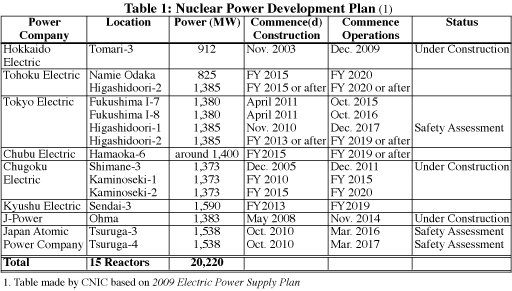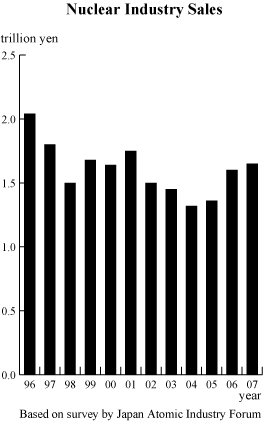2009 Fiscal Year Electric Supply Plan Nuke Info Tokyo No. 130
On April 3, the Ministry of Economy Trade and Industry’s Agency for Natural Resources and Energy released the 2009 Fiscal Year (FY09) Electric Supply Plan Outline. The Plan brings together the plans of all the electric power companies (EPCO). Although it is referred to as a “Plan”, as usual it has little relation to reality. A look at the plan for construction of new nuclear reactors reveals that the dates have been pushed back year after year. Some have been postponed for over 15 years.
Tohoku Electric’s Namie Odaka is the most glaring example. While 1,380MW ABWRs (Advanced Boiling Water Reactors) are the norm these days, the Namie Odaka plan is for an 825MW BWR. It was included in the plan over 40 years ago, but the construction commencement date has been pushed back year after year. Even if a decision is eventually made to construct the reactor, plant makers and parts manufacturers might not still maintain this out-of-date technology.

Predicted Demand Revised Downwards
Nevertheless, we can recognize some reality in the plan. The prediction for electric power demand was revised down in response to declining production, resulting from such factors as the international financial crisis.
The Plan predicts that the average rate of growth over the next 10 years will be around 0.8% for electric power demand (kilowatt hours) and around 0.6% for peak demand (kilowatts). Both figures are 0.1% less than last year’s prediction. Since the predicted growth of peak power demand was reduced 0.2% last year, this year’s figure is 0.3% less than the prediction in the FY07 Plan.
The Plan reverts to unreality in its prediction for the medium and long term, stating, “A gradual rise in the level of production is predicted in the medium to long term, in response to recovery in internal and external demand.”
EPCOs already have adequate reserve power supply, even with several nuclear power plants out of operation. Hamaoka 1 and 2 were shut down permanently in January (see NIT 128) and all seven Kashiwazaki-Kariwa reactors have been shut down for nearly two years (see article on page 1). Furthermore, they plan to bring on line more thermal power plants. From their point of view, delaying new nuclear construction plans is a good thing. If the plans proceeded according to schedule, they would be lumbered with huge excess capacity.
Some EPCOs predicted lower supply capacity in their FY09 plan than in their FY08 plan, giving the impression that they are reducing their reserve capacity. This was particularly pronounced in Tokyo Electric Power Company’s plan. Even as new supply sources are increasing, TEPCO reduced its prediction for total capacity in its plans for each of the last two years. It certainly seems that TEPCO does not need to restart KK.
Planned Reactors
EPCOs decide to construct power stations in response to increased peak demand, so as long as peak demand is not rising, they want to postpone construction of new nuclear power plants. Furthermore, as mentioned above, new nuclear power plants are larger than in the past. Since they are either operated at full power or not at all, their large capacity is very inconvenient. Consequently, construction commencement dates for 8 of the 13 existing reactor plans were postponed by one or two years.
This financial year Kyushu Electric added Sendai-3 and Chubu Electric added Hamaoka-6 to their supply plans. Both are very large reactors, so no doubt they too will be postponed year after year.
More Transparency Needed
Rather than seeking to provide cover for manifestly unrealistic government policy, EPCOs should disclose their real electric power supply plans in a transparent fashion. They should also reconsider their plans to introduce new thermal plants. It would help greatly if they got serious about renewable energy, instead of always putting obstacles in the way of the introduction of non-fossil, non-nuclear energy sources.
Nuclear Industry Developments in FY 2007
In February, the Japan Atomic Industrial Forum (JAIF) published the results of its nuclear industry survey. The results come from responses to a questionnaire by 11 EPCOs, 263 minerals and manufacturing companies and 23 trading companies.
According to this survey, total sales of minerals and manufacturing companies were 1.65 trillion yen in FY07. Sales are now on an upward trend after a low of 1.3 trillion yen in FY04. However, the increase in FY06 and FY07 was not in nuclear power plant construction. It was in other business, such as maintenance. Meanwhile, nuclear reactor machinery continued its downward trend.
The decline in orders was reversed and at the end of FY07 (31 March 2008) orders were 2.3 trillion yen. As explained in the above discussion of the Electric Power Supply Plan, EPCOs are not enthusiastic about new construction, so whether or not increased orders can be expected in future depends on the prospects of exports by the major manufacturers. Those prospects are far from clear.

Baku Nishio (CNIC Co-Director)
